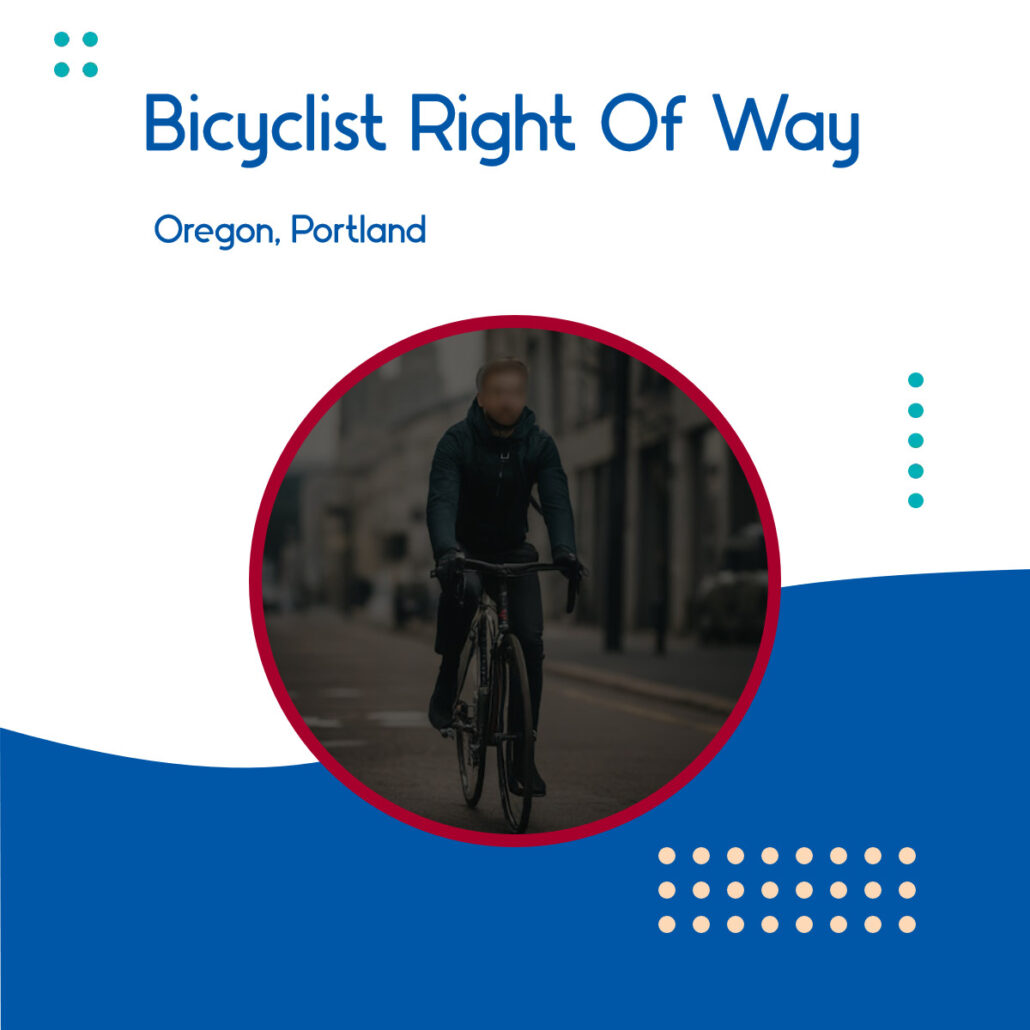Right of Way for Bicyclists
Welcome to our latest blog post, where we delve into the essential topic of right of way for bicyclists, with a specific focus on Oregon and Portland. This guide is not just for cyclists but also for motorists who share the roads. At Johnson Law, we specialize in personal injury law and are committed to promoting safety and legal knowledge on the road.

Note: The contents of this post are not legal advice and are for educational purposes only. If you need help with a legal matter please consult with a qualified attorney. We offer free consultations for personal injury cases.
We will review your case for free.
Pay us nothing unless we get you a better settlement.
We work on contingency.
Table of Contents
I. Basic Right of Way Rules for Bicyclists: A Nationwide Perspective
This section provides an essential foundation for understanding the specific rules and nuances on a national level. See our Portland Bicycle Accident Lawyer page for more Oregon specifics and help.
A. Understanding Right of Way in Traffic Right of way in traffic refers to rules that determine which road user has the priority in different scenarios. It's crucial for preventing accidents and ensuring smooth traffic flow. For bicyclists, understanding these rules means knowing when to yield and when they have the right of way, thus enhancing safety for all.
B. Nationwide Right of Way Rules for Bicyclists Across the United States, bicyclists are generally required to follow the same rules as motorists. This includes obeying traffic signals, stop signs, and yielding to pedestrians in crosswalks. Bicyclists are often granted the same rights and duties as drivers of vehicles, making it essential for them to understand these rules thoroughly.
C. Right of Way at Intersections and Crosswalks Intersections are common sites for accidents involving bicycles. Bicyclists must follow traffic signals and signs, yielding to oncoming traffic when turning left and to pedestrians in crosswalks. Understanding these intersection rules is vital for avoiding collisions.
D. Overtaking and Passing Regulations When a bicyclist overtakes or passes another vehicle, they must do so on the left and give a safe distance of at least three feet. Motorists are also required to give bicyclists adequate space when passing them. These regulations are designed to reduce the risk of sideswipe accidents.
E. Signaling and Turning: Key Aspects for Bicyclists Proper signaling is a crucial aspect of safe bicycling. Bicyclists should use hand signals to indicate turns and lane changes. This not only informs motorists and pedestrians of their intentions but also establishes their right of way in various traffic situations.
F. Common Misconceptions and Clarifications There are several misconceptions about bicyclists' right of way. For example, some believe bicyclists always have to yield to cars, which is not true. Bicyclists have equal rights on the road and should be treated as any other vehicle, with corresponding rights and responsibilities.
II. Right of Way for Bicyclists in Oregon
Through this section, Oregon bicyclists and motorists can gain a better understanding of the specific right of way rules and regulations, ensuring safer roads and more responsible road-sharing practices.
A. Overview of Oregon's Bicycling Laws Oregon's bicycling laws are designed to ensure safety and clarity on the road. While many of these laws align with nationwide standards, Oregon also has specific rules that address the unique needs of its cycling community. Understanding these laws is crucial for both cyclists and motorists to coexist harmoniously.
B. Lane Positioning and Usage In Oregon, bicyclists are required to ride as close to the right side of the road as practicable. However, exceptions are made when passing, turning left, avoiding hazards, or if the lane is too narrow to share safely with a motor vehicle. The use of bike lanes is encouraged but not mandatory, and cyclists must be aware of their right of way when moving in and out of these lanes.
C. Signaling and Turning in Oregon Bicyclists in Oregon must use hand signals to indicate their turning intentions. This includes extending the left arm for a left turn, the right arm for a right turn, and the left arm pointed down to signal stopping. These signals must be given continuously for at least 100 feet before turning or stopping unless both hands are required to control the bike.
D. Navigating Intersections and Roundabouts At intersections, Oregon bicyclists must follow the same rules as motor vehicles, including yielding to traffic in the intersection and obeying traffic signals and signs. In roundabouts, cyclists have the option to ride in the traffic lane or use the sidewalk or bike path, if available. They must yield to traffic already in the roundabout before entering.
E. Special Provisions for Bicyclists Oregon has laws that particularly benefit bicyclists, like the 'Bike Bill', which requires road projects to include facilities for pedestrians and cyclists. Also, the state's "stop as yield" law allows cyclists to treat stop signs as yield signs under certain conditions, enhancing the flow of bike traffic.
F. Right of Way in Crosswalks and Sidewalks When riding on sidewalks and in crosswalks, Oregon bicyclists have the same rights and duties as pedestrians. They must yield to pedestrians and give an audible signal before overtaking them. However, cyclists must also be cautious, as motorists might not always expect bicycles in these areas.
G. Legal Implications of Right of Way Violations Violating right of way rules can lead to accidents and legal consequences for bicyclists in Oregon. Such violations could not only result in traffic citations but also impact personal injury claims, where the failure to follow these rules could affect the outcome of legal proceedings and insurance settlements.
III. Focus on Portland: Bicycling Laws and Culture
Whether a resident or a visitor, cyclists can benefit from this information to ensure a safe and enjoyable riding experience in one of America's most bike-friendly cities.
A. Portland's Bicycling Infrastructure Portland is renowned for its commitment to bicycling, boasting an extensive network of bike-friendly streets and paths. The city has implemented specialized bicycle traffic signals in many areas, ensuring safer and more efficient travel for cyclists. This infrastructure not only promotes cycling as a mode of transportation but also underscores the city's dedication to cyclist safety.
B. Local Ordinances Impacting Bicyclists in Portland Portland's local ordinances sometimes go beyond state laws to further protect bicyclists. For example, certain areas of the city have lower speed limits to enhance safety for all road users, including cyclists. Understanding these local nuances is key for cyclists to navigate the city streets legally and safely.
C. Bicycle Boulevards and Shared Spaces Bicycle boulevards in Portland are designated routes that prioritize bicycle travel. These routes are typically on quieter streets and feature traffic calming measures to enhance safety. Shared spaces, where cyclists and pedestrians coexist, also feature prominently in Portland, requiring all users to be mindful of each other's right of way.
D. Safety Initiatives and Community Involvement Portland has various safety initiatives aimed at reducing accidents and encouraging safe cycling practices. Community involvement plays a significant role in these initiatives, with local organizations often partnering with the city to promote cycling education, awareness campaigns, and safety workshops.
E. Bicycling in Urban vs. Residential Areas Navigating the bustling streets of urban Portland requires cyclists to be especially aware of their surroundings and right of way rules. In contrast, residential areas might have more relaxed traffic but still require adherence to specific bicycling laws, particularly at intersections and near schools.
F. Special Considerations for Electric Bikes Electric bikes, or e-bikes, are becoming increasingly popular in Portland. The city has specific regulations for these bikes, such as speed limits and areas where they are allowed to operate. Understanding these rules is crucial for e-bike riders, especially regarding right of way and shared path usage.
G. Legal Resources and Support for Bicyclists Portland offers a range of legal resources and support for bicyclists. This includes access to legal advice specific to cycling accidents and incidents, advocacy groups focused on bicyclist rights, and educational resources to help cyclists understand their rights and responsibilities.
IV. Legal Assistance for Bicyclists: How Our Firm Can Help
At Johnson Law, we understand the complexities of bicycle laws in Oregon and Portland and are dedicated to helping cyclists who have been involved in accidents. Our experience in personal injury law, combined with a deep understanding of local bicycling regulations, positions us to offer comprehensive legal support to the cycling community.
A. Personal Injury Claims for Bicyclists If you're a bicyclist who has been injured in an accident, navigating the legal system can be overwhelming. Our team is skilled in handling personal injury claims specific to bicycling accidents. We work diligently to investigate the incident, gather evidence, and build a strong case to ensure you receive the compensation you deserve.
B. Navigating Insurance and Compensation Dealing with insurance companies can be challenging, especially after a cycling accident. Our firm is experienced in negotiating with insurance providers to ensure that our clients' rights are protected. We strive to secure fair compensation for medical expenses, lost wages, and other damages resulting from the accident.
C. Why Choose Our Firm for Bicycle-related Injuries Choosing the right legal representation is crucial. Our firm stands out due to our:
- Deep understanding of Oregon and Portland's specific bicycling laws.
- Proven track record in handling bicycle accident cases.
- Commitment to advocating for the rights and safety of bicyclists.
- Personalized approach, ensuring each client's unique needs are met.
D. Legal Consultation and Advice We offer consultations to bicyclists seeking legal advice. During these sessions, we provide insights into the legal options available and guide you through the steps necessary to protect your rights. Our goal is to empower you with knowledge and support, ensuring you make informed decisions regarding your case.
E. Community Outreach and Education We believe in promoting safe bicycling practices and legal awareness, contributing to a safer bicycling environment in Oregon and Portland. If you would like to join in this effort consider supporting Portland's Cycle Initiative.
At Johnson Law, we are not just legal advocates; we are advocates for the cycling community. Whether you need legal representation after an accident or simply seek advice on bicycling laws, our team is here to help.
VI. Summary
As we conclude this comprehensive guide on the right of way for bicyclists in Oregon and Portland, it’s important to reflect on the key takeaways:
- Understanding and Respect: Whether you’re a cyclist or a motorist, understanding and respecting the right of way rules is crucial for everyone’s safety. These rules aren’t just legal requirements; they are essential guidelines that help prevent accidents and facilitate smoother traffic flow.
- Oregon and Portland’s Unique Landscape: The specific laws and infrastructure in Oregon and, particularly, in Portland, highlight the state and city's commitment to promoting a safe and enjoyable cycling environment. It's vital for cyclists and drivers alike to familiarize themselves with these local nuances.
- Legal Support and Advocacy: Accidents happen, and when they do, it’s important to have knowledgeable and experienced legal support. At Johnson Law, we specialize in personal injury law. That includes cases related to bicycling incidents and we are dedicated to advocating for the rights and safety of cyclists.
- Ongoing Education and Awareness: Staying informed and up-to-date with bicycling laws and safety practices is a continuous process. We encourage both cyclists and motorists to engage in ongoing education and to participate in community initiatives that promote safe cycling.
- Invitation for Consultation and Legal Advice: If you find yourself in need of legal assistance or have questions about bicycling laws and safety, our doors at Johnson Law are always open. We are here to provide experienced legal advice and support, ensuring your rights are protected.
In closing, we hope this guide has been informative and helpful in understanding the right of way for bicyclists in Oregon and Portland. Safe cycling benefits everyone on the road, and by working together, we can ensure a safer, more harmonious experience for all. Remember, for any legal assistance or advice related to bicycling incidents, Johnson Law is here to help.
VII. FAQ
1. Do bicyclists always have to use bike lanes in Oregon and Portland?
- In Oregon, while bicyclists generally need to use bike lanes, they are not always legally required to do so. Cyclists may choose to ride in the main traffic lane if it’s safer or if they’re making a left turn, avoiding hazards, or passing another vehicle.
2. Can bicyclists treat stop signs as yield signs in Oregon?
- Yes, under Oregon’s “stop as yield” law, bicyclists are allowed to treat stop signs as yield signs in certain situations, provided they slow down and yield to any cross-traffic with the right of way.
3. Are electric bikes treated differently under Portland's bicycling laws?
- Electric bikes, or e-bikes, are subject to specific regulations in Portland. For instance, there are speed limits for e-bikes, and they may not be allowed on certain trails where traditional bicycles are permitted. It's important for e-bike riders to be aware of these specific rules.
4. What should I do if I’m involved in a bicycle accident in Oregon?
- If you’re involved in a bicycle accident, ensure your safety first, seek medical attention if needed, and contact the police to file a report. It’s also advisable to document the scene and gather contact information from witnesses. Then, consider consulting a legal professional, especially if you sustained injuries or there are disputes regarding fault.
5. How does right of way work in Portland’s shared spaces and bicycle boulevards?
- In shared spaces and bicycle boulevards in Portland, cyclists often share the road with pedestrians and other vehicles. The key is to follow signage, yield to pedestrians, and be mindful of other vehicles. Shared spaces are designed to promote safety and respect among all users.
6. Are there any special rules for bicycling in residential areas of Portland?
- While the general bicycling rules apply in residential areas, cyclists should be extra cautious due to the presence of children, pets, and slower-moving vehicles. Additionally, some residential areas might have specific local rules or traffic calming measures in place.
Feel free to reach out to our award-winning attorneys if you have more specific questions or need detailed advice on a particular situation. Our team is dedicated to providing accurate legal information and support to the bicycling community in Oregon and Portland.
VIII. Additional Resources
To further assist our readers in understanding bicycling laws and promoting safe cycling practices in Oregon and Portland, we have compiled a list of additional resources. These links and guides offer valuable information and support for both cyclists and motorists.
A. Oregon and Portland Bicycling Laws
- Oregon Department of Transportation (ODOT) – Bicycle Laws: Comprehensive guide to state bicycling laws. ODOT Bicycle Information
- City of Portland – Transportation Bicycling: Detailed information on Portland's specific bicycling ordinances and infrastructure. Portland Bicycling Information
B. Safety Guides and Tips
- Safe Routes to School: Information on safe bicycling practices for children and school communities. Safe Routes to School
C. Local Cycling Advocacy Groups
- The Street Trust: Advocacy group focusing on promoting and improving bicycling conditions in Oregon. The Street Trust
- Portland Bureau of Transportation (PBOT) – Active Transportation: Resources and initiatives aimed at encouraging active transportation modes like bicycling. PBOT Active Transportation
D. Legal Resources
- Johnson Law – Bicycle Law Resources: Our firm's collection of articles, FAQs, and legal advice for bicyclists. Our Bicycle Law Resources
- Oregon Bicycle Accident Report Form: A useful form to document a bicycle accident, which can be crucial for any legal proceedings. Bicycle Accident Report Form
E. Online Cycling Communities and Forums
- BikePortland Forum: A platform for Portland cyclists to discuss issues, share experiences, and connect. BikePortland Forum
- Oregon Cycling Forum: An online community for cyclists across Oregon to engage and share information. Oregon Cycling Forum
These resources offer a wealth of information and support, helping to ensure a safe and enjoyable cycling experience in Oregon and Portland. Whether you’re a seasoned cyclist or new to biking in the area, these resources can provide valuable guidance and community connections. If you would like a free personal injury consultation, remember that Johnson Law is here to provide trusted advice and support.
We will review your case for free.
Pay us nothing unless we get you a better settlement.
We work on contingency.

